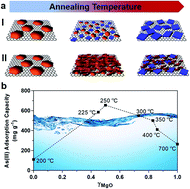当前位置:
X-MOL 学术
›
J. Mater. Chem. A
›
论文详情
Our official English website, www.x-mol.net, welcomes your
feedback! (Note: you will need to create a separate account there.)
Mg(OH)2–MgO@reduced graphene oxide nanocomposites: the roles of composition and nanostructure in arsenite sorption
Journal of Materials Chemistry A ( IF 10.7 ) Pub Date : 2017-11-02 00:00:00 , DOI: 10.1039/c7ta07629k Swasmi Purwajanti 1, 2, 3, 4, 5 , Xiaodan Huang 1, 2, 3, 4 , Yang Liu 1, 2, 3, 4 , Yannan Yang 1, 2, 3, 4 , Owen Noonan 1, 2, 3, 4 , Hao Song 1, 2, 3, 4 , Jun Zhang 1, 2, 3, 4 , Jing Zhang 1, 2, 3, 4 , Jianye Fu 1, 2, 3, 4 , Changhao Liang 6, 7, 8, 9 , Chengzhong Yu 1, 2, 3, 4
Journal of Materials Chemistry A ( IF 10.7 ) Pub Date : 2017-11-02 00:00:00 , DOI: 10.1039/c7ta07629k Swasmi Purwajanti 1, 2, 3, 4, 5 , Xiaodan Huang 1, 2, 3, 4 , Yang Liu 1, 2, 3, 4 , Yannan Yang 1, 2, 3, 4 , Owen Noonan 1, 2, 3, 4 , Hao Song 1, 2, 3, 4 , Jun Zhang 1, 2, 3, 4 , Jing Zhang 1, 2, 3, 4 , Jianye Fu 1, 2, 3, 4 , Changhao Liang 6, 7, 8, 9 , Chengzhong Yu 1, 2, 3, 4
Affiliation

|
Nanostructured MgO has been identified as a promising material for As(III) removal, however its application is hindered by one engineering drawback (nanoparticles cannot be directly used in wastewater treatment) and its performance is limited by two unanswered scientific questions: (1) which composition is the optimized one for As(III) sorption, MgO, Mg(OH)2 or a mixed composition? (2) If the sorption of As(III) relies on the formation of Mg(OH)2 after hydration of MgO, why does nanostructured Mg(OH)2 have generally low As(III) sorption performance? To address the challenges, we report the synthesis of Mg(OH)2–MgO@rGO nanocomposites with tunable compositions for arsenic sequestration for the first time. It is demonstrated that the nanocomposite with an optimized composition of Mg(OH)2–MgO has an exceptionally higher As(III) sorption capacity than pure Mg(OH)2 or MgO composition, reaching a maximum arsenite sorption capacity of 681.3 mg g−1 (equal to 866.0 mg g −1 As(III)/MgO). It is revealed that only the adsorbent with a balanced composition and reduced crystallinity generates interconnected Mg(OH)2 nanosheets in situ during the sorption process, providing abundant and accessible sites for As(III) sorption with enhanced sorption capacity. The rGO in the nanocomposite has multiple functions, including (1) reducing the size and crystallinity of Mg(OH)2–MgO, (2) favoring the formation of interconnected Mg(OH)2 nanosheets and (3) facilitating the oxidation of As(III) partially into As(V), all beneficial for enhanced arsenic sorption capacity. The Mg(OH)2–MgO@rGO nanocomposite has been applied to treat As(III) contaminated water in a household water treatment device with excellent performance. Our findings have provided new understanding in the rational design of highly efficient nanocomposite adsorbents for arsenite removal applications.
中文翻译:

Mg(OH)2 –MgO @还原的氧化石墨烯纳米复合材料:组成和纳米结构在砷吸附中的作用
纳米结构的MgO被认为是一种去除As(III)的有前途的材料,但是它的应用受到一个工程缺陷(纳米颗粒不能直接用于废水处理)的阻碍,并且其性能受到两个未解决的科学问题的限制:(1)成分是用于As(III)吸附,MgO,Mg(OH)2或混合成分的最佳组合?(2)如果MgO水化后,As(III)的吸附依赖于Mg(OH)2的形成,那么为什么纳米结构的Mg(OH)2通常具有较低的As(III)吸附性能?为了应对挑战,我们报告了Mg(OH)2的合成–具有可调节成分的MgO @ rGO纳米复合材料,首次用于砷的螯合。已经证明,用Mg(OH)的优化的组合物中的纳米复合材料2 -MgO具有特高的As(III)的吸附容量比纯Mg(OH)2或MgO的组合物,达到681.3毫克g的最大砷吸附能力- 1(等于866.0 mg g -1 As(III)/ MgO)。结果表明,只有具有平衡的组成和降低的结晶度的吸附剂在吸附过程中原位生成相互连接的Mg(OH)2纳米片,为As(III)提供了丰富而可及的位置)具有增强的吸附能力的吸附。纳米复合材料中的rGO具有多种功能,包括(1)减小Mg(OH)2 -MgO的尺寸和结晶度,(2)促进相互连接的Mg(OH)2纳米片的形成,以及(3)促进As的氧化(Ⅲ)部分转化为砷(Ⅴ),都有利于提高砷的吸附能力。Mg(OH)2 -MgO @ rGO纳米复合材料已被用于在家用水处理设备中以优异的性能处理As(III)污染的水。我们的发现为合理设计用于除砷的高效纳米复合吸附剂提供了新的认识。
更新日期:2017-11-17
中文翻译:

Mg(OH)2 –MgO @还原的氧化石墨烯纳米复合材料:组成和纳米结构在砷吸附中的作用
纳米结构的MgO被认为是一种去除As(III)的有前途的材料,但是它的应用受到一个工程缺陷(纳米颗粒不能直接用于废水处理)的阻碍,并且其性能受到两个未解决的科学问题的限制:(1)成分是用于As(III)吸附,MgO,Mg(OH)2或混合成分的最佳组合?(2)如果MgO水化后,As(III)的吸附依赖于Mg(OH)2的形成,那么为什么纳米结构的Mg(OH)2通常具有较低的As(III)吸附性能?为了应对挑战,我们报告了Mg(OH)2的合成–具有可调节成分的MgO @ rGO纳米复合材料,首次用于砷的螯合。已经证明,用Mg(OH)的优化的组合物中的纳米复合材料2 -MgO具有特高的As(III)的吸附容量比纯Mg(OH)2或MgO的组合物,达到681.3毫克g的最大砷吸附能力- 1(等于866.0 mg g -1 As(III)/ MgO)。结果表明,只有具有平衡的组成和降低的结晶度的吸附剂在吸附过程中原位生成相互连接的Mg(OH)2纳米片,为As(III)提供了丰富而可及的位置)具有增强的吸附能力的吸附。纳米复合材料中的rGO具有多种功能,包括(1)减小Mg(OH)2 -MgO的尺寸和结晶度,(2)促进相互连接的Mg(OH)2纳米片的形成,以及(3)促进As的氧化(Ⅲ)部分转化为砷(Ⅴ),都有利于提高砷的吸附能力。Mg(OH)2 -MgO @ rGO纳米复合材料已被用于在家用水处理设备中以优异的性能处理As(III)污染的水。我们的发现为合理设计用于除砷的高效纳米复合吸附剂提供了新的认识。











































 京公网安备 11010802027423号
京公网安备 11010802027423号